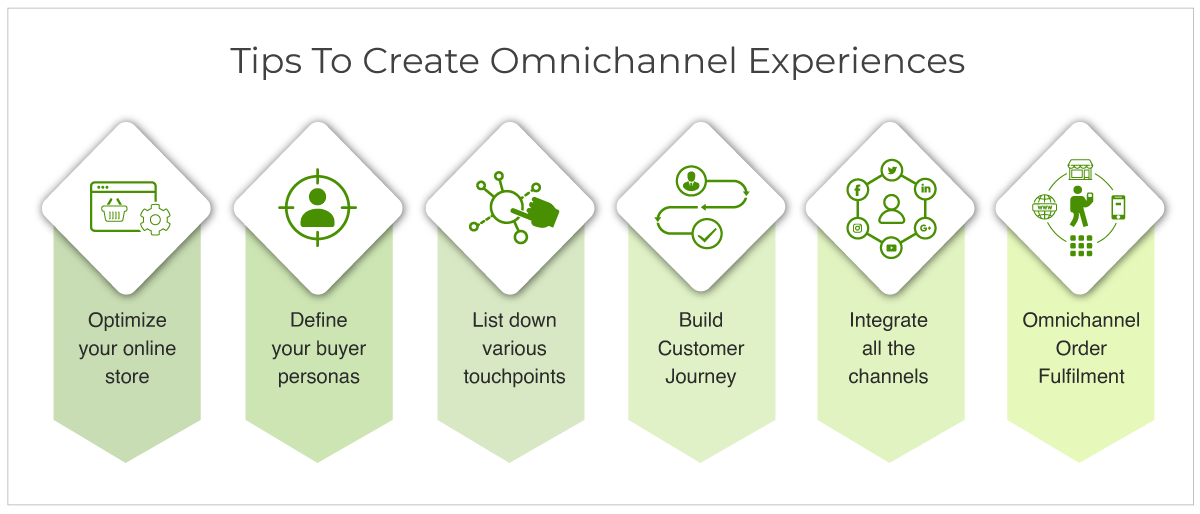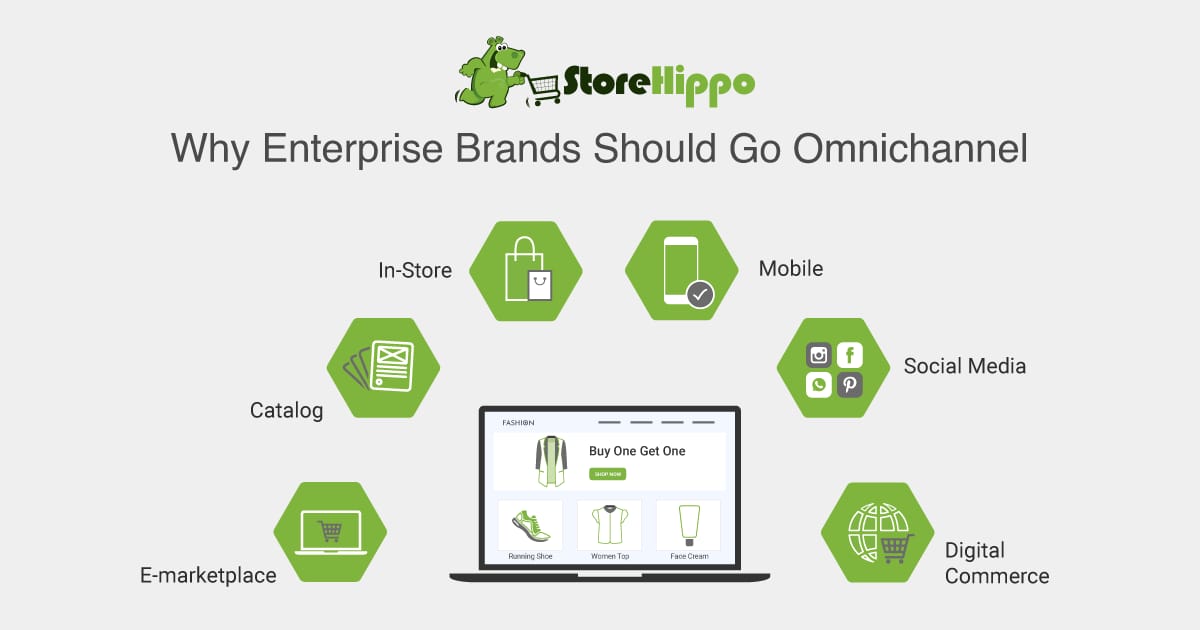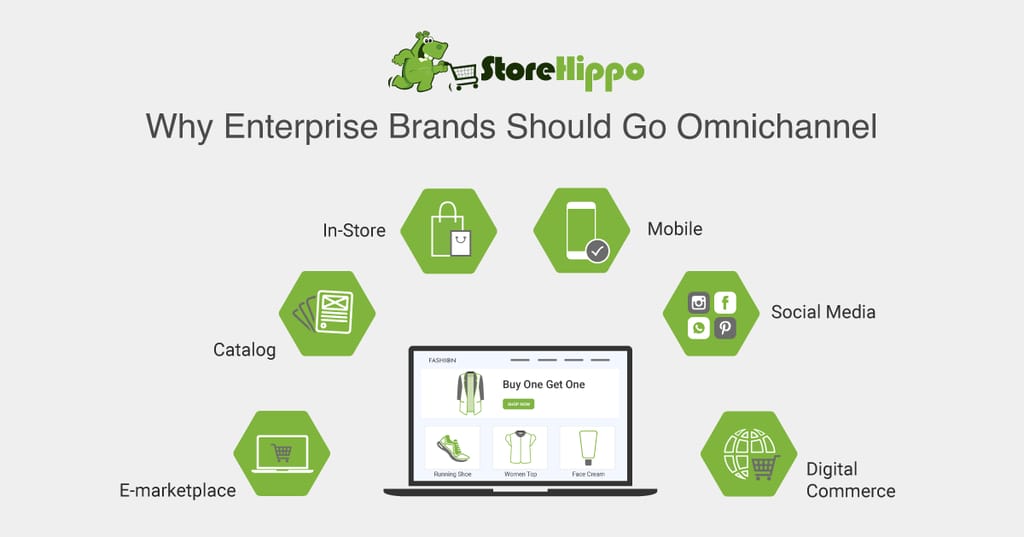The ecommerce industry is identified as the most disruptive business model. Why? Because it introduces a non-conventional method of shopping on all kinds of channels using advanced technology, which people never imagined 30 years ago.
Take the example of two disruptive enterprise ecommerce brands ~ Amazon and Alibaba ~ that have been making online selling / buying easy and affordable for consumers and businesses, since their inception. Because of their unique omnichannel approach which includes personalization on each channel / device, connected shopping experience between two channels, and even more; people love to buy from them till today.
For this reason and many other positive approaches, they have a huge market share ~
Amazon shares 13.7% of the global retail e-commerce
Alibaba shares an 8.4% market share of global ecommerce
Now here is the real question ~ What specific technology or strategies do these enterprise brands use to ace their omnichannel approach?
Let's learn everything about omnichannel step by step. Ready?
Table of Contents
- What is an Omnichannel approach?
- Benefits of omnichannel to enterprise ecommerce
- 1. Reach new customer segments & boost brand awareness
- 2. Increase Revenue and sales
- 3. Increase operational efficiency
- 4. Improve inventory turnover
- 1. Optimize your online store
- 2. Define your buyer personas
- 3. List down various touchpoints
- 4. Build customer journey
- 5. Integrate all the channels
- 6. Give omnichannel order fulfillment options
- Amazon
- Pepperfry
- Omnichannel technologies you need for disruptive returns
- How does the StoreHippo ecommerce solution help brands go Omnichannel?
- Final Takeaway
What is an Omnichannel approach?
Do you know how many channels or devices D2C customers use to shop online? Let's count them. Channels can be enormous, but here are some popular ones ~
Omnichannel touchpoint-
Desktop and mobile website
Social media page
Google Shopping ads
Youtube channel
Brick-n-mortar store.
Devices can be mobile, tablets, smart speakers (like Amazon Alexa, Siri, Google Nest), smartwatches, and more
Buyers can be unpredictable sometimes, you can never guess which channel they are going to purchase from your business. Hence, you need to give them a seamless experience, no matter which channel or device they use to shop. And this is what we call omnichannel ecommerce.
In simple words, it is a practice by enterprise ecommerce businesses to offer seamless customer experience by interconnecting all the online and offline shopping channels via headless technology and other advanced technology. The objective is to give personalized D2C experience and better communication with ecommerce brands.
What do you need to know about D2C omnichannel Buyers?
In general, a D2C buyer employs about six touchpoints before purchasing a product; whereas about 50% of them make regular use of more than four touchpoints
Over 63% of customers want personalized communication and marketing offers based on their previous purchases ( Retail Customer Experience )
D2C Buyers are likely to spend more dollars on online stores that offer intense omnichannel personalization, even when they want to buy limited stuff. ( Think With Google )
About 91% of consumers are likely to share data with brands who address customer personalization needs like relevant offers, sales and product recommendations . ( Accenture )
Benefits of omnichannel to enterprise ecommerce
1. Reach new customer segments & boost brand awareness
An omnichannel strategy benefits businesses by enabling them to reach new customer segments. This benefit is nearly equally important to both leading retailers and 'others' (48% vs. 45%), but both numbers should be higher, as reaching new customers is a key to growth.
2. Increase Revenue and sales
Companies with a strong omnichannel strategy retain an average of 89% of their customers and the average customer retention rate is 39%. As it is a significant percentage, enterprises should go on integrating all channels together.
3. Increase operational efficiency
The omnichannel approach comes with a myriad of advantages ~ High operational efficiency, less operating costs, easy data collection, etc. You only have to collect customer's data once, rather than at every touchpoint and can thus design customer experience based on the data that is consistent on every channel.
4. Improve inventory turnover
Forget about the days when used to lose revenue because some items are out of stock. Businesses can get a better overview of inventory , and better control over orders fulfillment. Enterprise ecommerce stores can optimize their stock levels and develop smarter replenishment plans.

1. Optimize your online store
The first step is to prepare your website to kickstart the omnichannel strategy. Here is the list of things you need to fix asap:
Design a responsive site that loads fast on mobile devices, tablets, desktops, and other smart devices
Improve your site navigation for friction-free movement between product pages
Integrate social media pages into your ecommerce platform. You can add share icons on each product page for quick sharing. Example: Add buttons of WhatsApp, Facebook, Gmail, that are usually used for communication
2. Define your buyer personas
Here are some great ways to gather valuable data when defining your customer personas:
Integrate Google Analytics to your site and get access to visitors behavior.
[Tip] Use the "Behavior Flow" and "Goal Flow" reports to see how visitors are moving between touchpoints.
Launch Facebook ads campaign to quickly attract customers and learn more about them.
[Secret] Facebook is the cheapest and fastest way to land new customers.
[Pro Tip] Study your social media followers who interact with your brands as well as your competitor's social followers. You will get a hell of rich insights
Conduct consumer surveys and questionnaires
[Free Tip] Reward them for completing surveys like giving shopping points that could further so that they shop to avail them.
- Interview sales executives who regularly interact with customers.
By following such tactics, you will be able to gather customer desires, pain points, interests, ages, hobbies, professions, demographics, etc; and can easily use them to create a better omnichannel experience.
3. List down various touchpoints
A touchpoint refers to a point of contact when your customer interacts with your enterprise ecommerce brand. And it takes an average of seven touchpoints with your brand before a purchase will take place. Based on such interactions, customers often form the first impression of a brand and make an opinion about the product or service.
Examples of Touchpoints
An online advertisement: Google Ads, Facebook ads, youtube ads, etc.
Brick-n-mortar store
Mobile App and ecommerce site
Social media Pages
Live chat and Chatbots
Media coverage in an online magazine or newspaper with links to band sites like press releases, short interviews, articles, etc
Google search results of your online store, for both branded and non-branded terms
An email newsletter or sales email
Product listing on multi vendor marketplace sites like Amazon, Flipkart, Myntra, eBay, Etsy, etc
Billboards, hoardings and banners on roads, public transport, malls, etc
4. Build customer journey
After defining personas and touchpoints, the next move is to map a customer journey. A customer journey has usually 4 stages:
1. Awareness stage (early): An early stage, where a customer hasn't heard about your products / brand. In this stage, you have to capture their attention, introduce your products and showcase your credibility.
D2C Omnichannel strategies to use during this stage:
List down various channels where your buyer personas are active. Example: Facebook, Instagram, LinkedIn, etc
Run awareness ads on social media platforms . Choose platforms wisely; ideally, it should be decided based on your target audience
Run PPC ads on various google and Youtube to create a buzz about your brand
2. Consideration stage: In this stage, buyers already know about your enterprise ecommerce brand and are planning to consider your products. So, currently, the buyer is researching and comparing your products with other similar ones. They look for customer reviews about your products, customer service, returns and exchanges, delivery, and other aspects, etc that contribute to the customer shopping experience.
So, here are some D2C Omnichannel tactics:
Collect customer reviews , testimonials and videos about your product on your websites, app, social media pages and marketplace sites
Approach industry influencers to promote and review your product on their website, social profiles, podcast, etc. Give them a coupon code , which they can share with their followers / subscribers for an additional discount
[Secret] Best way to earn customer trust, as people consider these influencers as experts in their respective niche.
- Write blogs, make youtube videos and post social media content consistently on all channels.
3. Purchase stage: The stage where a customer has to make a final decision of either purchasing from you or your competitor. Here the buyer will examine your credibility and trustworthiness. They will also look at the price, features, and utility of the product; plus additional perks.
Here are tactics you need to use for fast conversions:
Give free deliveries, easy exchanges and returns
Give multiple payment methods for friction-free checkouts
Give discounts, coupons, loyalty points, free membership or any other marketing offer that can lure them to purchase
Run remarketing campaigns for customers who forgot to buy after adding items to carts
4. Retention stage: After a customer has purchased, it is important to keep them engaged with your enterprise ecommerce store. As you now have intuitive data about their needs, preferences, demographics, etc; you can now easily send relevant sales offers, product recommendations, etc directly to their mail inbox or phone number.
5. Integrate all the channels
Centralize data from all your sources and channels to determine the best ways to balance inventory, meet customers where they are and provide the best service, wherever they shop.
Connect social media platforms, mobile apps, chatbots, Google Analytics, Google Ads, marketing software, Google Analytics, CRM, payment partner, shipping solution , etc with your app and website.
6. Give omnichannel order fulfillment options
What are Omnichannel fulfillment options? It is combining various channels (offline and online) for customer convenience and satisfaction. Here are some examples:
Buy in-store, deliver to the customer
Buy online, return in-store
Reserve online, pickup in-store
Buy online, pickup in-store
Online returns or exchanges
Examples of companies with the best omnichannel approach
Amazon
Amazon is the king of the omnichannel experience in retail ecommerce. It has not left any channel untapped. Amazon app and website uses technology that automatically syncs buyers shopping carts, no matter from which device / channel they sign in. For “Prime” members, regardless of device or platform, can access prime benefits without feeling like they're being compensated less if they switch from platform to platform.
Pepperfry
Pepperfry offers an omnichannel experience by connecting its ecommerce store with an in-person experience. As a result, customers can browse the product on-site, choose the product, and can visit a nearby "Studio Pepperfry" to experience the quality of the product in real-time.
In the studio, there will be an interior design consultant who guides customers and passes personalized suggestions on selecting the perfect furniture, based on their home requirements. If the furniture fits the customer's requirements, he / she is given 2 types of buying methods ~ Buy in-store or Buy online on a website / app. Eventually, the flexibility in buying and paying on different channels reduces friction between customers and salespeople as leads do not feel coerced to make an in-store purchase.
Omnichannel technologies you need for disruptive returns
Customers' top priorities while browsing online stores are fluid navigation, easy checkout , personalized web experience, fast shipping, or returns. Here is how you can fulfill them ie by using the best omnichannel technologies:
1. Headless CMS
A technology that allows businesses to decouple their front-end user interface from their back-end ecommerce data solutions.
Example: If you tell Alexa to open and add to cart the latest iPhone model, you're using headless tech.
How headless works: Role and Benefits?
Quick integration: Ace omnichannel retail game by integrating tools like live chat, marketing software, shipping solution, etc via Headless commerce API. Headless architecture is based on APIs, which is used for easy communication between channels, devices, or within the site. You can share content, market and sell content on all platforms
Offers multiple personalization options: allows you to customize the frontend of your online store and offer a personalized user experience without making any backend changes
Accelerate customer acquisition: It helps you to understand your customers better, improve your learnings to gain better customer conversions, and enhance your business growth in future. You can craft dynamic and real-time personalized experiences by using a headless CMS
Give control over User Interface: As the frontend and backend of your enterprise site is separated; this lets your developers and marketers do quick product update, inventory update, etc with no technical skills
Expand commerce channels: Want to sell to wider audiences scattered across various channels, that too, with extreme personalization? Get started with headless as it helps in creating a seamless customer experience across various channels with the least effort
2. Artificial intelligence and machine learning
AI has proven to improve the omnichannel approach of retailers because it helps enterprise ecommerce stores to do consistent targeting on all platforms.
How can your enterprise business use AI to support omnichannel efforts?
Purchase recommendation
Voice-enabled shopping assistants
Image and voice search
Hyper-targeted notifications and emails
Image and video recognition for advertisements
Facial recognition payment methods
Automatic location detection
Profile building of potential customers
Example of companies using AI at best:
Amazon uses AI to help customers do voice shopping as well as get highly targeted purchase recommendations on their site and app, along with advanced technology . Not only this but Amazon's AI technology is also used for facial recognition, estimating home prices, visual search, autonomous driving and more.
3. 24/7 available chatbots and Live chats
There are a lot of questions your customers want to ask like where's my order? Recommend me some best selling dishwashers, etc. AI Chatbots acts as an assistant for answering such commonly asked questions. To prove their worth to the D2C ecommerce brand , I am listing down reasons to enable chatbots and live chat features.
Why Chatbots?
87% of people were satisfied with live chats fully managed by chatbots
Automatic greetings, questions, etc make customer service easier and less time-consuming
Features like file and media sharing, make chats more engaging. Because customers can explain their needs via images, which is sometimes difficult to express in words
Bots like Facebook messenger, WhatsApp messenger, etc can be used to send promotional messages on various channels. Thus, empowering your omnichannel engagement
Why live chats?
Live Chats plugins are cheaper than phones as they are cloud-based and only require a small subscription fee
Requires fewer agents as chat gives them the benefit of multitasking while solving customers issues
The cost of unique interaction is minimal
Best way to connect with customers and boost their loyalty as well as conversions
4. Automation
Want to reduce manual tasks? In ecommerce, there are lots of tasks that take time like delivery tracking, payment processing, marketing and advertisements, preparing reports, gathering customer data, managing orders , updating inventory levels, improving site navigation and aesthetics and beyond. Hence, automation becomes a necessity
Storehippo offers automated delivery management via its admin panel. You can get a complete overview of your orders within a single click. When an order is approved, the inventory gets automatically updated. Shipping orders is also easy, where you just need to enter a few details, choose delivery service, and schedule item pickup within a few clicks. Plus, you can create GST compliant bulk invoices at a click with the help of ready-made invoice templates.
StoreHippo also provides marketing tools that simplify day to day marketing operations. With SEO tools , one-click integration to third party marketing tools, automatic push notifications , web notifications, and other advanced technologies; you can reduce manual, time-consuming tasks. Consequently, the marketing team can concentrate more on generating revenue and increasing brand value.
5. OmniChannel Payment gateways and Shipping solution
When everything is going to be OmniChannel, why leave payment and shipping solutions behind? Make sense? Definitely!
Omnichannel payment system: It is a system that integrates all the business payment operations together, providing a single view of your customer interactions as well as revenue. By implementing them, all your payment data gets unified, which in turn, gives a comprehensive view of individual shopper payment trends. You can deliver engaging, personalized and consistent customer journeys on any active channel
Omnichannel logistics: Type of solutions that seeks to establish a connection between inventory, logistics and distribution operation across all sales channels to meet consumer demand. With these solutions, we can easily process returns, exchanges, order delivery, in-store pick-up, etc at any channel ie online and offline. Example: Online order and in-store purchase return management
How does the StoreHippo ecommerce solution help brands go Omnichannel?
With 300+ API endpoints and 300+ inbuilt ecommerce features , StoreHippo is the best enterprise ecommerce platform to implement OmniChannel strategy as it offers inbuilt capabilities of the headless content management system, automation, AI, and more.
Collect customer data from various channels with the StoreHippo inbuilt tool. By segregating data, you can orchestrate customer journeys and offer personalized experiences at each step of the customer journey across multiple channels. All of this is possible with StoreHippo headless commerce solutions .
Furthermore, to ensure effortless customer service, Storehippo offers automated tools and features like social media and live chat integration, email and SMS notifications, feedback surveys, app notification, etc to serve customers on live channels. You can even integrate all-in-one custom chat to offer support to customers via online chat , phone, email, or social media.
Final Takeaway
I think this wealth of knowledge and tips on omnichannel retail is enough to start. Right? So now it's implementation time. And for that, you need an ecommerce solution that offers all omnichannel technology in one place. Need help in selecting one? Sign up for a 14-day free trial to learn more about how StoreHippo advanced technologies (headless, AI, etc) can boost your enterprise ecommerce success.





















4 Comments
Leave a Reply
Leave a Reply
Leave a Reply
Leave a Reply